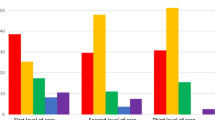Abstract.
Background:
This study investigated the extent to which occupational therapists and social workers employed in Australian mental health settings are affected by burnout.
Method:
Questionnaires were sent to occupational therapists and social workers who had indicated that they were interested in participating in the study. An overall response rate of 76.6% (n = 304) was achieved. The outcome measure was the Maslach Burnout Inventory (comprising emotional exhaustion, depersonalisation and personal accomplishment scales).
Results:
There were no significant differences, with respect to any of the three burnout scales, between occupational therapists and social workers. Both groups experienced high emotional exhaustion, moderate depersonalisation, and high personal accomplishment. Levels of burnout were not significantly different between inpatient and community staff.
Conclusions:
These results suggested that, while occupational therapists and social workers reported emotional exhaustion, there was less evidence of depersonalisation and they reported very high personal accomplishment in their work. Results are congruent with those of previous studies and it is argued that the focus of future research should be on identifying characteristics of mental health work that contribute to emotional exhaustion.
Similar content being viewed by others
References
Australian Health Ministers (1998) Second national mental health plan. Canberra: Commonwealth Department of Health and Family Services
Brown G, Pranger T (1992) Predictors of burnout for psychiatric occupational therapy personnel. Can J Occupational Therapy 59:258–267
Collings J, Murray P (1996) Predictors of stress amongst social workers: an empirical study. Br J Soc Work 26:375–387
Cushway D, Tyler P, Nolan P (1996) Development of a stress scale for mental health professionals. Br J Clin Psychol 35:279–295
Edwards D, Burnard P, Coyle D, Fothergill A, Hannigan B (2000) Stress and burnout in community mental health nursing: A review of the literature. J Psychiatr Ment Health Nurs 7:7–14
Greaves A, King R, Yellowlees P, Spence S, Lloyd C (2002) The competence of mental health occupational therapists. Br J Occupational Therapy 65:381–386
Harper H, Minghella E (1997) Pressures and rewards of working in community mental health teams. Mental Health Care 1:18–21
Maslach C, Jackson S, Leiter M (1996) Maslach burnout inventory. Palo Alto, California: Consulting Psychologists Press, Inc
Martin U, Schinke S (1998) Organizational and individual factors influencing job satisfaction and burnout of mental health workers. Soc Work Health Care 28:51–62
National Mental Health Strategy Evaluation Steering Committee (1997) Evaluation of the National Mental Health Strategy: final report. Canberra: Mental Health Branch, Commonwealth Department of Health and Family Services
Onyett S, Pillinger T, Muijen M (1997) Job satisfaction and burnout among members of community mental health teams. J Ment Health 6:55–66
Pranger T, Brown G (1992) Burnout: an issue for psychiatric occupational therapy personnel? Occupational Therapy Mental Health 12:77–92
Prosser D, Johnson S, Kuipers E, Szmukler G, Bebbington P, Thornicroft G (1996) Mental health, ‘burnout’ and job satisfaction among hospital and community-based mental health staff. Br J Psychiatry 169:334–337
Prosser D, Johnson S, Kuipers E, Dunn G, Szmukler G, Reid Y, Bebbington P, Thornicroft G (1999) Mental health, ‘burnout’ and job satisfaction in a longitudinal study of mental health staff. Soc Psychiatry Psychiatr Epidemiol 34:295–300
Rabin C, Zelner D (1992) The role of assertiveness in clarifying roles and strengthening job satisfaction of social workers in multidisciplinary mental health settings. Br J Soc Work 22:17–32
Reid Y, Johnson S, Morant N, Kuipers E, Szmukler G, Thornicroft G, Bebbington P, Prosser D (1999) Explanations for stress and satisfaction in mental health professionals: a qualitative study. Soc Psychiatry Psychiatr Epidemiol 34:301–308
Rogers J, Dodson S (1988) Burnout in occupational therapists. Am J Occupational Therapy 42:787–792
Sturgess J, Poulsen A (1983) The prevalence of burnout in occupational therapists. Occupational Therapy in Mental Health 3:47–60
Soderfeldt M, Soderfeldt B, Warg L (1995) Burnout in social work. Soc Work 40:638–646
Whiteford H, Macleod B, Leitch E (1993) The national mental health policy: Implications for public psychiatric services in Australia. Aust N Z J Psychiatry 27:186–191
Author information
Authors and Affiliations
Corresponding author
Rights and permissions
About this article
Cite this article
Lloyd, C., King, R. A survey of burnout among Australian mental health occupational therapists and social workers. Soc Psychiatry Psychiatr Epidemiol 39, 752–757 (2004). https://doi.org/10.1007/s00127-004-0808-7
Accepted:
Issue Date:
DOI: https://doi.org/10.1007/s00127-004-0808-7



